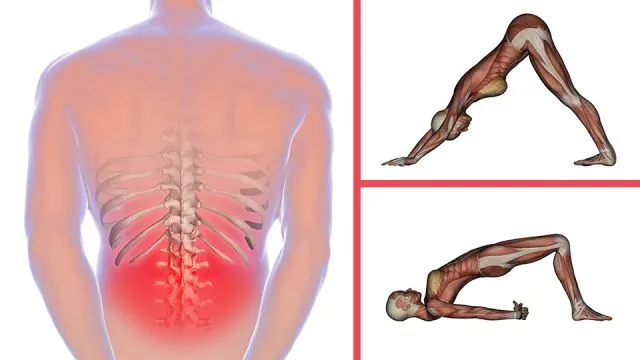
- Share on Facebook674
- Share on Pinterest
- Share on Twitter
If you have pain, weakness, numbness or a tingling sensation that begins in your lower back, runs through the buttock and all the way down the back of one leg, you could have sciatica. Sciatica is caused by a pinched nerve in the lower back. Nonsteroidal anti-inflammatory drugs (NSAIDs) may relieve pain, temporarily. But they often come with unwanted and potentially dangerous side effects. Here are four ways to help relieve pain and even prevent or minimize future sciatica pain and dysfunction.
1. Stretching out the pain
A study published in the Journal of Neurosurgery: Spine suggests that over five percent of the adult population in the U.S. suffers from sciatica. Moreover, a person has a 40 percent likelihood of experiencing sciatica over his or her life. These two simple stretches are helpful for reducing the inflammation as well as relieving the pain.
Note: stretching the muscle too aggressively may provoke sciatic pain. So, it’s important to proceed carefully.
1. Lie down on the floor and bend the knee of the aching leg. Next, cup your hands under the knee and pull it slightly towards the shoulder in a gentle stretch. Remain in the position for about 30 seconds. Finally, straighten your legs and take a short break. Repeat the same exercise two times.
2. Still lying on the floor in a supine position, bend both knees keeping your buttocks on the floor. Then, cross the legs (sore leg over healthy leg). Cup your hands under the healthy leg and pull the knees gently. Stay in this position for about 30 seconds. Then release your legs and return to the starting position. Repeat two times.
2. Try yoga for pain relief
Lengthening the spine with yoga not only helps develop good posture but also helps reduce stiffness, inflammation and pain. Studies suggest that yoga is safe and beneficial for people with sciatica. For instance, if your sciatica is the result of a herniated disk, gentle poses that progress to standing poses and the downward-facing dog position will lengthen and strengthen your lower back, and help keep it aligned.
In fact, according to Yoga International, yoga can even help you manage pain and reduce the problems often associated with a herniated disk. Here’s how to try it:
- Prep for the seated spinal twist: Sit on a folded blanket or yoga mat with your knees bent and your feet planted on the floor in front of you. Now place your right foot under your left knee, pointing forward. Steady yourself by holding your left knee with your hands. Inhale and lengthen upward through your spine. If the stretch is too much for you or if you feel pain down your leg, add a little more padding under your hips. Remain in this pose about two minutes. Repeat on the other side. Complete four sets.
- Simple seated twist: Remaining in the seated position, with the right foot under left knee, turn toward the upright knee. To help your upper body turn fully, place your left hand on the floor behind you and continue holding your left knee with your right hand. Now, inhale to lift, lengthen and expand. Keep your chest lifted and the natural inward curve in your lower back. As you exhale, twist without rounding your back. Keep your hand on your left knee to gently draw that knee toward your chest. Relax your inner thigh and groin muscle, allowing it to soften downward toward the sit bone.
- Easier and milder standing twist: This twist is perfect for anyone who struggles to lower themselves into a sitting position and raise themselves from the floor. It’s also a milder version of the seated twist. Place a chair against the wall. To stretch your right hip, stand with your right side next to the wall and place your right foot on the chair. Keep your knee bent and your standing leg straight. You can steady your balance by placing your right hand on the wall. Lift your left heel up, and stand on the ball of your foot. Now turn your body toward the wall. Exhale, lowering your left heel to the floor. Maintain the twist and hold for several breaths.
3. Acupuncture for relief
Acupuncture, used in traditional Chinese medicine, achieves or maintains better health by opening the body’s natural flow of energy. Tiny, pain-free needles are used to target specific pathways in the body. Acupuncture can provide relief from sciatica pain without adverse side effects. Studies show that acupuncture stimulates the production of endorphins — the body’s own natural painkillers — creating balance, pain relief and support for the body’s natural healing process.
4. Apply heat or ice
For acute pain, applying heat or ice packs can help alleviate the leg pain, especially in the initial phase, suggests Spine Health. Apply heat or ice for about 20 minutes, and repeat every two hours. Most people ice first, but some find better relief with heat. However, the two may be alternated. Use a cloth or towel when applying the ice to prevent ice burn.
The number one reasons you’re experiencing sciatic nerve pain is because of inflammation or a herniated disk. Before reaching for NSAIDs, talk to your doctor about incorporating some gentle stretches or yoga into your daily routine. You may find that it not only relieves the pain but also prevents your sciatica from returning.
— Katherine Marko
- Share on Facebook674
- Share on Pinterest
- Share on Twitter

